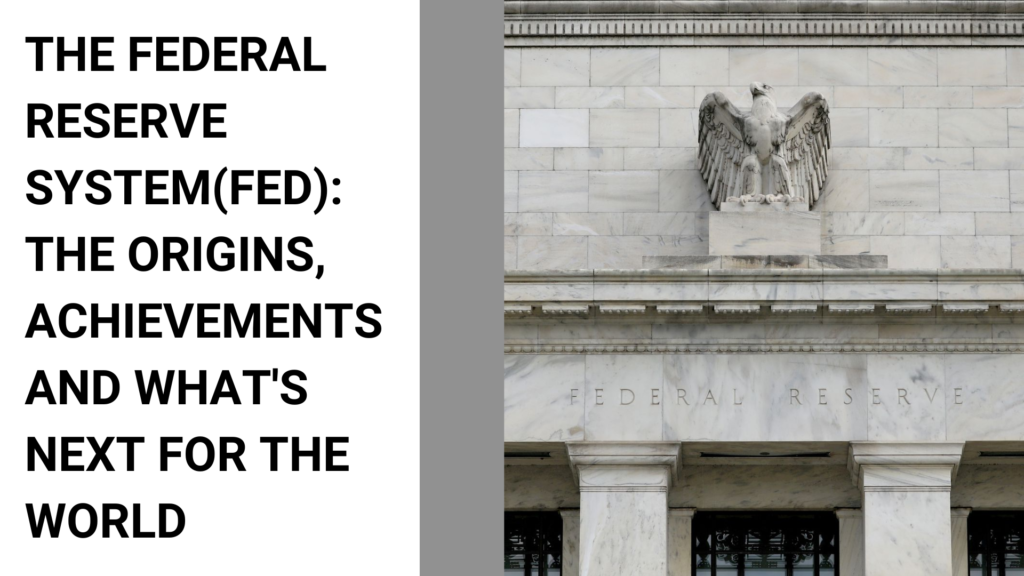
The US dollar is one of the strongest currencies in the world, and the US is one of the biggest economies in the world as well. The happening of any event in the country affects the overall market.
With the FED meeting around the corner and it having so much impact on the market, it’s important to know who the FED is and what it was built for.
So without further adieu, let’s begin!!
Origins of the FED:
The Federal Reserve System, or FED is the central bank of the United States of America. It was founded in 1913 by Congress through an Act.
In the 1860s, the National Banking Act created a difficult environment in which most of the nation’s currency consisted of notes issued by only national banks. The quantity of US government bonds held by a national bank determined the number of notes it could issue. When an unexpected event or piece of news prompted bank customers to fear for the security of their deposits and “run” to their banks to withdraw cash, the supply of notes was mostly impervious to fluctuations in demand.
Amidst this, there was a demand for liquidity and a desire for “elastic” currency, and this led to the creation of the Federal Reserve and a new currency form – The Federal Reserve note.
Federal Reserve System(FED) – The Beginning:
The FED was created with a purpose in mind. ‘Making the American banking system more stable’.
In its earlier year, the FED achieved a lot of landmark events. One of the main things it dealt with was the “inelastic currency” problem by creating an entirely new currency – the Federal Reserve note. In addition to this, they also made a system to get the notes out quickly into circulation as well. A system was made wherein National banks were required to purchase capital in reserve banks, and also they gained access to loans and other services.
The New Payment System:
The FED not only revolutionized the American banking system but created a new currency and made payments more efficient and rapid. The reserve bank provided check clearing services for their member banks. At the time, they even developed an electronic system for making long-distance payments a reality using telegraphs. This was later known as Fedwire.
Monetary Policy:
The Fed’s early years also included the introduction of monetary policy in the modern sense. Even though the Federal reserve act didn’t have a monetary policy, they took it upon themselves to introduce it.
Securities and Exchanges:
To accomplish its macroeconomic goals the Fed started modifying its discount rate and buying and selling US government assets in the 1920s. When the economy fell into recessions in 1924 and 1927, the Fed bought securities. The Fed liquidated securities in 1928 as authorities sought to impose stricter credit restrictions to reduce speculative activity on the stock market. The Federal Reserve’s (Fed) apparent effectiveness in tweaking the monetary policy levers in the 1920s appeared to imply that the new central bank could control the business cycle and maintain price stability. But in the 1930s, when the United States experienced the worst economic slump in its history, everything went wrong.
FED rates hike – Past 10 years:
The FED has been a constant entity that has saved the US from a total economic breakdown. This was mostly done by the FED by raising interest rates. Let’s see how many times this has happened throughout history.
The Federal Reserve adjusts the federal funds target rate range in response to the economic scenario in the Country. Several factors such as the Fed’s monetary policy decisions, GDP, consumer spending and industrial product as also financial crises, global pandemics or terrorist attacks lead the FED to make adjustments.
Fed Rate Hikes (2015 – 2018):
After the market crash in 2008, the world economy was in shambles. The Fed slashed the rate to zero to help the US economy cope with the fallout from the 2008 global financial crisis. After 7 years after the event, the Central Bank began raising rates as the economy recovered from the event.
The first rate increase was on December 17, 2015, from 0.25% to 0.50%, and the final one that lead to the normalcy of the economy was on December 20, 2018.
The FOMC took its time to return to a normal monetary policy stance but that was until the changes that occurred in 2019.
Fed Rate Cuts in 2019:
Throughout the year, there were rate cuts from August 1, 2019, to October 31, 2019. In August it was 2.0% to 2.23 %. Then on October 31, 2019, the reduction was brought up to 1.50%.
The US and the Chinese trade war was occurring, and due to this, the FED did the rate change to save the country from high unemployment rates. In the second half of the year, these rate hikes provided a positive effect on the economy.
Covid-19 FED Rate Cuts – 2020:
From March 3 – 16th, rate cuts were made from 1.0% to 0.25%. These were done in emergency meetings in March 2020, returning the Fed funds target range of zero to 0.25%.
Fed Rate Hikes – 2022 & 2023:
From March 17th to May 03rd, the rate has risen from 0.25% to a whopping 5.25%. This consistent rate hike was to reduce the inflation that was occurring in the US.
Final Note:
The Fed holds meeting 8 times each year, and several global markets are affected just by the decisions made in the meeting. With its over 100-year history, the Fed has been a constant factor that sends impulses through the market, thereby directing analysts, investors and traders to make the right moves.
We’ll be back with more case studies like this soon. So stay tuned and also keep visiting.
Commodity Samachar
Learn and Trade with Ease
